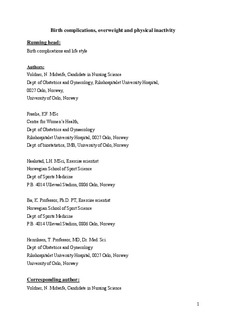| dc.contributor.author | Voldner, Nanna | |
| dc.contributor.author | Frøslie, Kathrine Frey | |
| dc.contributor.author | Haakstad, Lene Annette Hagen | |
| dc.contributor.author | Bø, Kari | |
| dc.contributor.author | Henriksen, Tore | |
| dc.date.accessioned | 2010-05-07T08:38:33Z | |
| dc.date.available | 2010-05-07T08:38:33Z | |
| dc.date.issued | 2009-05 | |
| dc.identifier | Seksjon for idrettsmedisinske fag / Department of Sports Medicine | |
| dc.identifier.citation | Acta Obstetricia et Gynecologica Scandinavica. 2009, 88(5), 550-555 | en_US |
| dc.identifier.issn | 0001-6349 | |
| dc.identifier.uri | http://hdl.handle.net/11250/171020 | |
| dc.description | I Brage finner du siste tekst-versjon av artikkelen, og den kan inneholde ubetydelige forskjeller fra forlagets pdf-versjon. Forlagets pdf-versjon finner du på www.informahealthcare.com: http://dx.doi.org/10.1080/00016340902818162 / In Brage you'll find the final text version of the article, and it may contain insignificant differences from the journal's pdf version. The original publication is available at www.informahealthcare.com: http://dx.doi.org/10.1080/00016340902818162 | en_US |
| dc.description.abstract | Objective. Maternal lifestyle factors are potential predictors of pregnancy complications. We examined relations between
modifiable factors and delivery complications. Design. Prospective cohort. Setting. University hospital antenatal clinic, Oslo,
Norway. Sample. A cohort of 553 women followed through pregnancy and delivery. Main outcome measures. Pre-specified
birth complications: cesarean section (CS), operative vaginal deliveries (VDs), third and fourth degree of perineal
lacerations and hemorrhage (]1,000 ml). Methods. Univariate and multiple logistic regression analyses were performed.
Besides high birthweight (]4,200 g), modifiable predictors (high body mass index (BMI), fasting glucose and physical
inactivity) and non-modifiable predictors (parity, maternal age, gestational age, and gender) were considered. Results.
Significant predictors for induction of labor were parity (odds ratio (OR): 2.1; 95% CI 1.3 3.5), maternal age (OR: 2.0; 1.2
3.4), gestational age (OR: 1.9; 1.1 3.1), and BMI ]30 (OR: 4.2; 2.2 7.8, pB0.01). High birthweight and high BMI were
overrepresented among CSs. Emergency CS was associated with birthweight (OR: 3.7; 1.7 8.1), parity (OR: 3.5; 1.7 7.2),
maternal age (OR: 2.6; 1.3 5.3), and induction of labor (OR: 4.8; 2.6 9.1). After excluding CS, operative VD was
associated with parity (OR: 8.7; 3.8 20) and gender (OR: 2.2; 1.2 14.1). Perineal laceration was associated with pregestational
physical inactivity (OR: 6.1; 1.6 22.9) and operative VD (OR: 5.1; 1.5 17.6). Hemorrhage was associated with
high birthweight (OR: 4.2; 1.2 4.7) and BMI ]30 (OR: 4.6; 1.2 17.7). Conclusions. Pre-gestational physical inactivity
increased the risk of perineal lacerations and male infants were associated with higher risk of vaginal operative delivery. | en_US |
| dc.language.iso | eng | en_US |
| dc.publisher | Taylor & Francis | en_US |
| dc.subject | birth complications | en_US |
| dc.subject | physical activity | en_US |
| dc.subject | perineal lacerations | en_US |
| dc.title | Birth complications, overweight, and physical inactivity | en_US |
| dc.type | Journal article | en_US |
| dc.type | Peer reviewed | en_US |
| dc.subject.nsi | VDP::Medical disciplines: 700 | en_US |
| dc.source.pagenumber | 550-555 | |
